Abstract
We determined nuclear DNA content from 308 archival paraffin-embedded malignant breast tumours and evaluated the survival of the patients by univariate and multivariate statistical analyses. The overall 8-year survival rate of stage I-III breast cancer patients was 74.3% in DNA-diploid and 51.2% in DNA-aneuploid tumours (P less than 0.0001). DNA ploidy had prognostic significance in both node-negative and node-positive breast cancer, primarily in cases with steroid receptor-positive tumours. In a Cox multivariate analysis DNA ploidy (P = 0.001), primary tumour size (P = 0.0007), nodal status (P = 0.04) and the content of progesterone receptors (P = 0.0008) emerged as significant independent prognostic factors, whereas oestrogen receptor status, age and menopausal status of the patients had no significant independent prognostic value. If the histological grade of ductal carcinomas was also included in the Cox model, both grade and DNA ploidy had independent prognostic effect. In conclusion, our results indicate that the analysis of DNA ploidy is a useful adjunct in the assessment of prognosis for breast cancer patients.
Full text
PDF
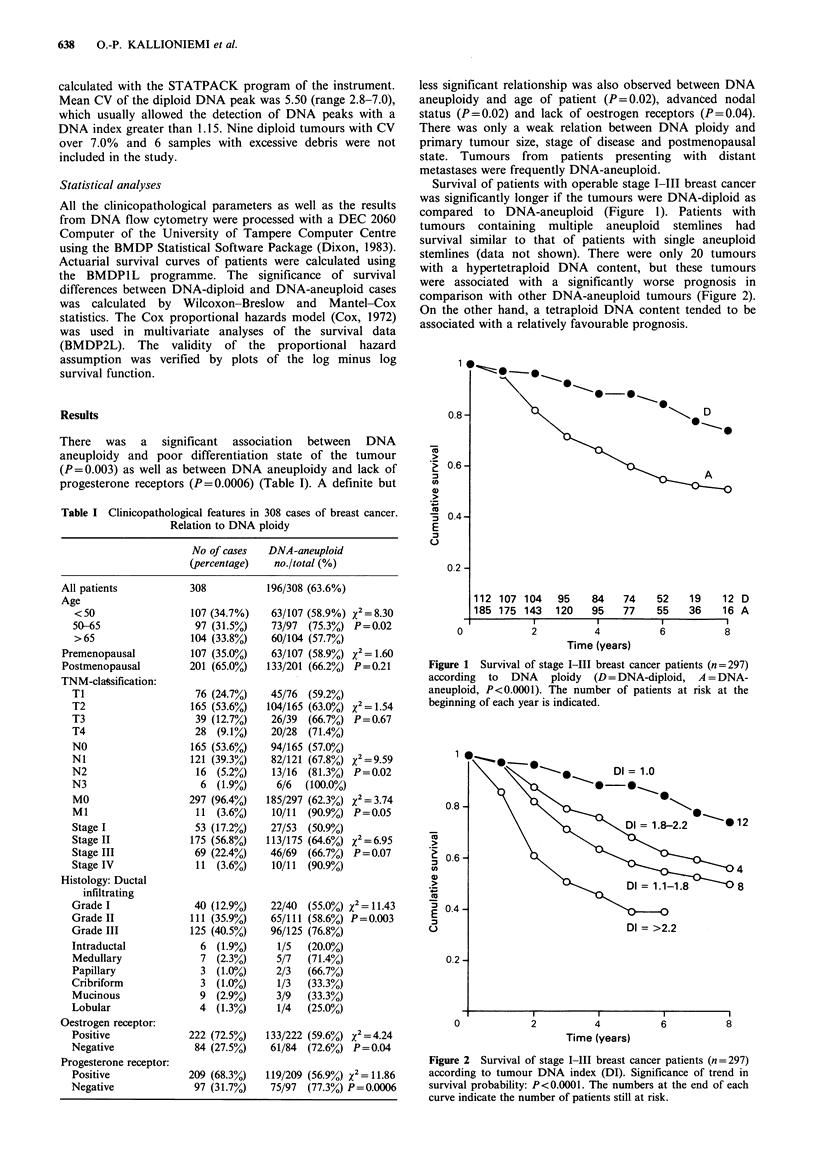
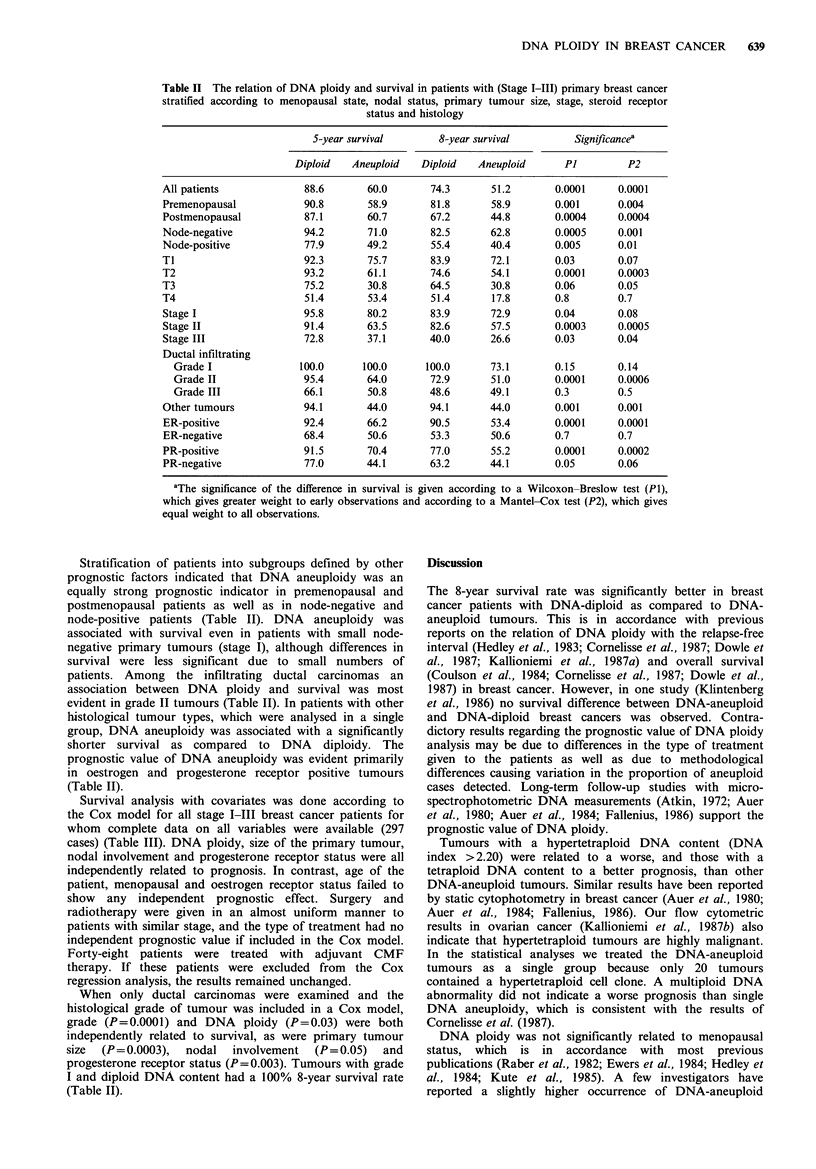
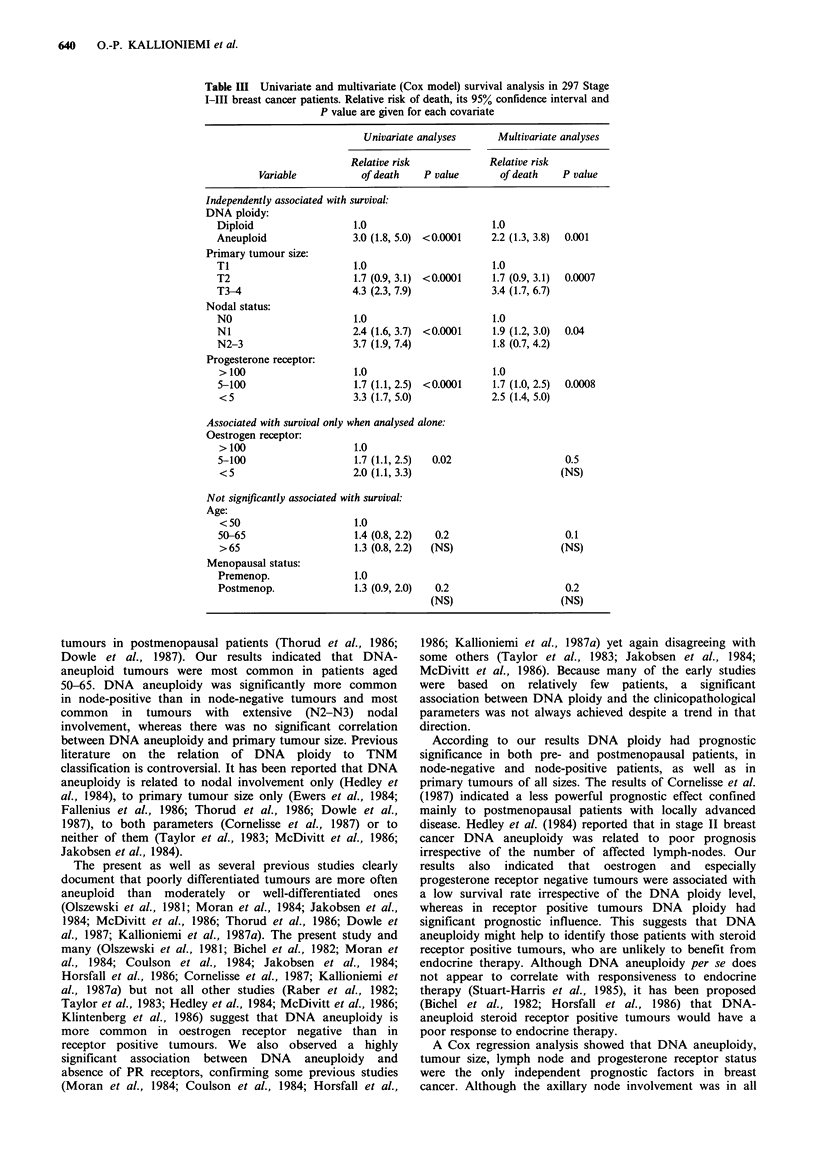
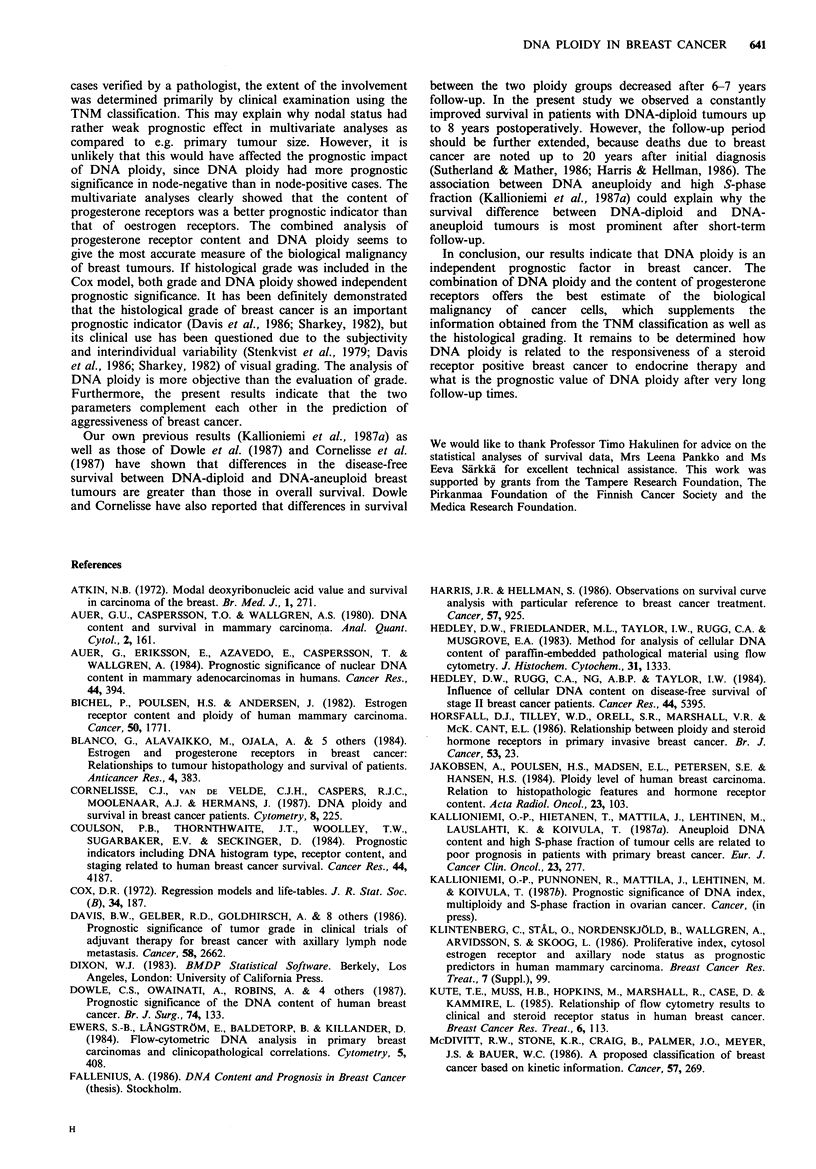
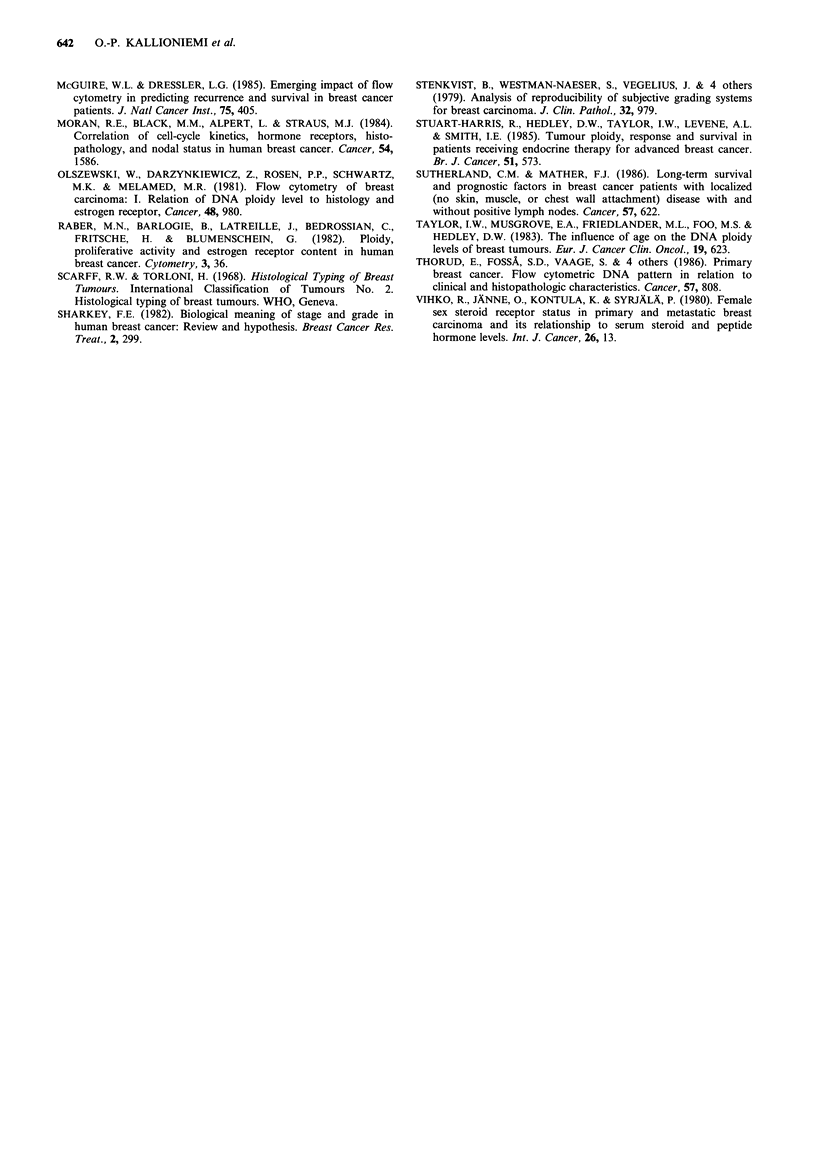
Selected References
These references are in PubMed. This may not be the complete list of references from this article.
- Atkin N. B. Modal deoxyribonucleic acid value and survival in carcinoma of the breast. Br Med J. 1972 Jan 29;1(5795):271–272. doi: 10.1136/bmj.1.5795.271. [DOI] [PMC free article] [PubMed] [Google Scholar]
- Auer G. U., Caspersson T. O., Wallgren A. S. DNA content and survival in mammary carcinoma. Anal Quant Cytol. 1980 Sep;2(3):161–165. [PubMed] [Google Scholar]
- Auer G., Eriksson E., Azavedo E., Caspersson T., Wallgren A. Prognostic significance of nuclear DNA content in mammary adenocarcinomas in humans. Cancer Res. 1984 Jan;44(1):394–396. [PubMed] [Google Scholar]
- Bichel P., Poulsen H. S., Andersen J. Estrogen receptor content and ploidy of human mammary carcinoma. Cancer. 1982 Nov 1;50(9):1771–1774. doi: 10.1002/1097-0142(19821101)50:9<1771::aid-cncr2820500921>3.0.co;2-7. [DOI] [PubMed] [Google Scholar]
- Blanco G., Alavaikko M., Ojala A., Collan Y., Heikkinen M., Hietanen T., Aine R., Taskinen P. J. Estrogen and progesterone receptors in breast cancer: relationships to tumour histopathology and survival of patients. Anticancer Res. 1984 Nov-Dec;4(6):383–389. [PubMed] [Google Scholar]
- Cornelisse C. J., van de Velde C. J., Caspers R. J., Moolenaar A. J., Hermans J. DNA ploidy and survival in breast cancer patients. Cytometry. 1987 Mar;8(2):225–234. doi: 10.1002/cyto.990080217. [DOI] [PubMed] [Google Scholar]
- Coulson P. B., Thornthwaite J. T., Woolley T. W., Sugarbaker E. V., Seckinger D. Prognostic indicators including DNA histogram type, receptor content, and staging related to human breast cancer patient survival. Cancer Res. 1984 Sep;44(9):4187–4196. [PubMed] [Google Scholar]
- Davis B. W., Gelber R. D., Goldhirsch A., Hartmann W. H., Locher G. W., Reed R., Golouh R., Säve-Söderbergh J., Holloway L., Russell I. Prognostic significance of tumor grade in clinical trials of adjuvant therapy for breast cancer with axillary lymph node metastasis. Cancer. 1986 Dec 15;58(12):2662–2670. doi: 10.1002/1097-0142(19861215)58:12<2662::aid-cncr2820581219>3.0.co;2-y. [DOI] [PubMed] [Google Scholar]
- Dowle C. S., Owainati A., Robins A., Burns K., Ellis I. O., Elston C. W., Blamey R. W. Prognostic significance of the DNA content of human breast cancer. Br J Surg. 1987 Feb;74(2):133–136. doi: 10.1002/bjs.1800740221. [DOI] [PubMed] [Google Scholar]
- Ewers S. B., Långström E., Baldetorp B., Killander D. Flow-cytometric DNA analysis in primary breast carcinomas and clinicopathological correlations. Cytometry. 1984 Jul;5(4):408–419. doi: 10.1002/cyto.990050419. [DOI] [PubMed] [Google Scholar]
- Harris J. R., Hellman S. Observations on survival curve analysis with particular reference to breast cancer treatment. Cancer. 1986 Mar 1;57(5):925–928. doi: 10.1002/1097-0142(19860301)57:5<925::aid-cncr2820570508>3.0.co;2-l. [DOI] [PubMed] [Google Scholar]
- Hedley D. W., Friedlander M. L., Taylor I. W., Rugg C. A., Musgrove E. A. Method for analysis of cellular DNA content of paraffin-embedded pathological material using flow cytometry. J Histochem Cytochem. 1983 Nov;31(11):1333–1335. doi: 10.1177/31.11.6619538. [DOI] [PubMed] [Google Scholar]
- Hedley D. W., Rugg C. A., Ng A. B., Taylor I. W. Influence of cellular DNA content on disease-free survival of Stage II breast cancer patients. Cancer Res. 1984 Nov;44(11):5395–5398. [PubMed] [Google Scholar]
- Jakobsen A., Poulsen H. S., Madsen E. L., Petersen S. E., Hansen H. S. Ploidy level of human breast carcinoma. Relation to histopathologic features and hormone receptor content. Acta Radiol Oncol. 1984;23(2-3):103–107. doi: 10.3109/02841868409135997. [DOI] [PubMed] [Google Scholar]
- Kallioniemi O. P., Hietanen T., Mattila J., Lehtinen M., Lauslahti K., Koivula T. Aneuploid DNA content and high S-phase fraction of tumour cells are related to poor prognosis in patients with primary breast cancer. Eur J Cancer Clin Oncol. 1987 Mar;23(3):277–282. doi: 10.1016/0277-5379(87)90071-x. [DOI] [PubMed] [Google Scholar]
- Kute T. E., Muss H. B., Hopkins M., Marshall R., Case D., Kammire L. Relationship of flow cytometry results to clinical and steroid receptor status in human breast cancer. Breast Cancer Res Treat. 1985;6(2):113–121. doi: 10.1007/BF02235742. [DOI] [PubMed] [Google Scholar]
- McDivitt R. W., Stone K. R., Craig R. B., Palmer J. O., Meyer J. S., Bauer W. C. A proposed classification of breast cancer based on kinetic information: derived from a comparison of risk factors in 168 primary operable breast cancers. Cancer. 1986 Jan 15;57(2):269–276. doi: 10.1002/1097-0142(19860115)57:2<269::aid-cncr2820570214>3.0.co;2-d. [DOI] [PubMed] [Google Scholar]
- McGuire W. L., Dressler L. G. Emerging impact of flow cytometry in predicting recurrence and survival in breast cancer patients. J Natl Cancer Inst. 1985 Sep;75(3):405–410. [PubMed] [Google Scholar]
- Moran R. E., Black M. M., Alpert L., Straus M. J. Correlation of cell-cycle kinetics, hormone receptors, histopathology, and nodal status in human breast cancer. Cancer. 1984 Oct 15;54(8):1586–1590. doi: 10.1002/1097-0142(19841015)54:8<1586::aid-cncr2820540820>3.0.co;2-9. [DOI] [PubMed] [Google Scholar]
- Olszewski W., Darzynkiewicz Z., Rosen P. P., Schwartz M. K., Melamed M. R. Flow cytometry of breast carcinoma: I. Relation of DNA ploidy level to histology and estrogen receptor. Cancer. 1981 Aug 15;48(4):980–984. doi: 10.1002/1097-0142(19810815)48:4<980::aid-cncr2820480421>3.0.co;2-7. [DOI] [PubMed] [Google Scholar]
- Raber M. N., Barlogie B., Latreille J., Bedrossian C., Fritsche H., Blumenschein G. Ploidy, proliferative activity and estrogen receptor content in human breast cancer. Cytometry. 1982 Jul;3(1):36–41. doi: 10.1002/cyto.990030109. [DOI] [PubMed] [Google Scholar]
- Stenkvist B., Westman-Naeser S., Vegelius J., Holmquist J., Nordin B., Bengtsson E., Eriksson O. Analysis of reproducibility of subjective grading systems for breast carcinoma. J Clin Pathol. 1979 Oct;32(10):979–985. doi: 10.1136/jcp.32.10.979. [DOI] [PMC free article] [PubMed] [Google Scholar]
- Stuart-Harris R., Hedley D. W., Taylor I. W., Levene A. L., Smith I. E. Tumour ploidy, response and survival in patients receiving endocrine therapy for advanced breast cancer. Br J Cancer. 1985 Apr;51(4):573–576. doi: 10.1038/bjc.1985.80. [DOI] [PMC free article] [PubMed] [Google Scholar]
- Sutherland C. M., Mather F. J. Long-term survival and prognostic factors in breast cancer patients with localized (no skin, muscle, or chest wall attachment) disease with and without positive lymph nodes. Cancer. 1986 Feb 1;57(3):622–629. doi: 10.1002/1097-0142(19860201)57:3<622::aid-cncr2820570338>3.0.co;2-c. [DOI] [PubMed] [Google Scholar]
- Taylor I. W., Musgrove E. A., Friedlander M. L., Foo M. S., Hedley D. W. The influence of age on the DNA ploidy levels of breast tumours. Eur J Cancer Clin Oncol. 1983 May;19(5):623–628. doi: 10.1016/0277-5379(83)90178-5. [DOI] [PubMed] [Google Scholar]
- Thorud E., Fosså S. D., Vaage S., Kaalhus O., Knudsen O. S., Børmer O., Shoaib M. C. Primary breast cancer. Flow cytometric DNA pattern in relation to clinical and histopathologic characteristics. Cancer. 1986 Feb 15;57(4):808–811. doi: 10.1002/1097-0142(19860215)57:4<808::aid-cncr2820570421>3.0.co;2-#. [DOI] [PubMed] [Google Scholar]
- Vihko R., Jänne O., Kontula K., Syrjälä P. Female sex steroid receptor status in primary and metastatic breast carcinoma and its relationship to serum steroid peptide hormone levels. Int J Cancer. 1980 Jul 15;26(1):13–21. doi: 10.1002/ijc.2910260104. [DOI] [PubMed] [Google Scholar]


